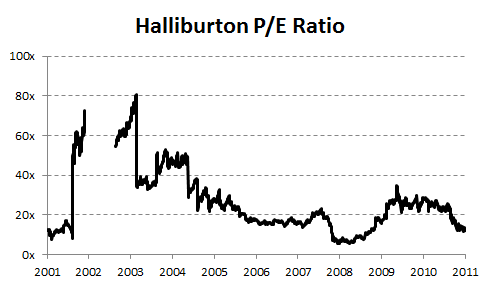A Brief History of Halliburton's Returns
Despite constant attempts by analysts and the media to complicate the basics of investing, there are only three ways a stock can create value for shareholders:
Dividends.
Earnings growth.
Changes in valuation multiples.
In this series, we drill down on one company's returns to see how each of those three has played a role over the past decade. Step on up, Halliburton (NYS: HAL) .
Halliburton shares returned 467% over the last decade. How'd they get there?
Dividends accounted for a good chunk. Without dividends, shares returned 391% over the last 10 years.
Earnings growth was substantial. Halliburton's normalized earnings per share grew at an average rate of 18% a year from 2001 until today. That's far above the market average, and easily ahead of rivals Schlumberger (NYS: SLB) and Baker Hughes (NYS: BHI) .
Now have a look at the company's valuation multiple:

Source: S&P Capital IQ.
The big spike and subsequent gap around 2002 was caused by a temporary dearth of earnings. Ignore it. What's important is that Halliburton's earnings multiple is about the same today as it was 10 years ago.
That's fairly rare these days. Most large-cap companies were overvalued a decade ago, and falling multiples ever since have prevented earnings growth from turning into shareholder returns. Since Halliburton shares were fairly valued 10 years ago -- who wanted to own a lowly energy services company during the dot-com bubble, after all -- shareholder returns ever since have tracked earnings growth, fueling above-average returns. This is a simple observation that drives home one of the most important lessons in investing: starting valuations determine future returns.
Why is this stuff worth paying attention to? It's important to know not only how much a stock has returned, but where those returns came from. Sometimes earnings grow, but the market isn't willing to pay as much for those earnings. Sometimes earnings fall, but the market bids shares higher anyway. Sometimes both earnings and earnings multiples stay flat, but a company generates returns through dividends. Sometimes everything works together, and returns surge. Sometimes nothing works and they crash. All tell a different story about the state of a company. Not knowing why something happened can be just as dangerous as not knowing that something happened at all.
Add Halliburton to My Watchlist.
At the time thisarticle was published Fool contributor Morgan Housel doesn't own shares in any of the companies mentioned in this article. Follow him on Twitter @TMFHousel. Try any of our Foolish newsletter services free for 30 days. We Fools may not all hold the same opinions, but we all believe that considering a diverse range of insights makes us better investors. The Motley Fool has a disclosure policy.
Copyright © 1995 - 2011 The Motley Fool, LLC. All rights reserved. The Motley Fool has a disclosure policy.

